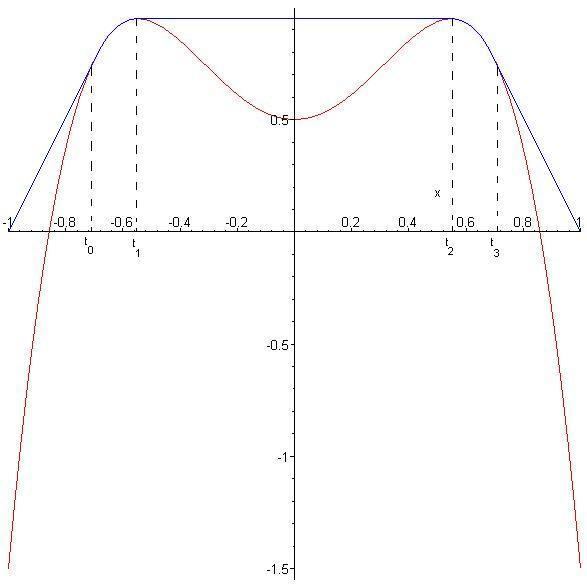 | ||
The obstacle problem is a classic motivating example in the mathematical study of variational inequalities and free boundary problems. The problem is to find the equilibrium position of an elastic membrane whose boundary is held fixed, and which is constrained to lie above a given obstacle. It is deeply related to the study of minimal surfaces and the capacity of a set in potential theory as well. Applications include the study of fluid filtration in porous media, constrained heating, elasto-plasticity, optimal control, and financial mathematics.
Contents
- Historical note
- Shape of a membrane above an obstacle
- Optimal stopping
- Formal statement
- Variational inequality
- Least superharmonic function
- Optimal regularity
- Level surfaces and the free boundary
- Generalizations
- References
The mathematical formulation of the problem is to seek minimizers of the Dirichlet energy functional,
in some domain
In general, the solution is continuous and possesses Lipschitz continuous first derivatives, but that the solution is generally discontinuous in the second derivatives across the free boundary. The free boundary is characterized as a Hölder continuous surface except at certain singular points, which reside on a smooth manifold.
Historical note
Qualche tempo dopo Stampacchia, partendo sempre dalla sua disequazione variazionale, aperse un nuovo campo di ricerche che si rivelò importante e fecondo. Si tratta di quello che oggi è chiamato il problema dell'ostacolo.
Shape of a membrane above an obstacle
The obstacle problem arises when one considers the shape taken by a soap film in a domain whose boundary position is fixed (see Plateau's problem), with the added constraint that the membrane is constrained to lie above some obstacle
This problem can be linearized in the case of small perturbations by expanding the energy functional in terms of its Taylor series and taking the first term only, in which case the energy to be minimized is the standard Dirichlet energy
Optimal stopping
The obstacle problem also arises in control theory, specifically the question of finding the optimal stopping time for a stochastic process with payoff function
In the simple case where the process is Brownian motion, and the process is forced to stop upon exiting the domain, the solution
Formal statement
Suppose the following data is given:
- an open bounded domain
D ⊂ ℝn with smooth boundary - a smooth function
f ( x ) on ∂D (the boundary ofD ) - a smooth function
φ ( x ) defined on all ofD such thatφ | ∂ D f , i.e. the restriction ofφ ( x ) to the boundary ofD (its trace) is less thanf .
Then consider the set
which is a closed convex subset of the Sobolev space of square integrable functions with square integrable weak first derivatives, containing precisely those functions with the desired boundary conditions which are also above the obstacle. The solution to the obstacle problem is the function which minimizes the energy integral
over all functions
Variational inequality
The obstacle problem can be reformulated as a standard problem in the theory of variational inequalities on Hilbert spaces. Seeking the energy minimizer in the set
where ⟨ . , . ⟩ : ℝn × ℝn → ℝ is the ordinary scalar product in the finite-dimensional real vector space ℝn. This is a special case of the more general form for variational inequalities on Hilbert spaces, whose solutions are functions
for coercive, real-valued, bounded bilinear forms
Least superharmonic function
A variational argument shows that, away from the contact set, the solution to the obstacle problem is harmonic. A similar argument which restricts itself to variations that are positive shows that the solution is superharmonic on the contact set. Together, the two arguments imply that the solution is a superharmonic function.
In fact, an application of the maximum principle then shows that the solution to the obstacle problem is the least superharmonic function in the set of admissible functions.
Optimal regularity
The solution to the obstacle problem has
- If the obstacle
ϕ ( x ) has modulus of continuityσ ( r ) , that is to say that| ϕ ( x ) − ϕ ( y ) | ≤ σ ( | x − y | ) , then the solutionu ( x ) has modulus of continuity given byC σ ( 2 r ) , where the constant depends only on the domain and not the obstacle. - If the obstacle's first derivative has modulus of continuity
σ ( r ) , then the solution's first derivative has modulus of continuity given byC r σ ( 2 r ) , where the constant again depends only on the domain.
Level surfaces and the free boundary
Subject to a degeneracy condition, level sets of the difference between the solution and the obstacle,
Generalizations
The theory of the obstacle problem is extended to other divergence form uniformly elliptic operators, and their associated energy functionals. It can be generalized to degenerate elliptic operators as well.
The double obstacle problem, where the function is constrained to lie above one obstacle function and below another, is also of interest.
The Signorini problem is a variant of the obstacle problem, where the energy functional is minimized subject to a constraint which only lives on a surface of one lesser dimension, which includes the boundary obstacle problem, where the constraint operates on the boundary of the domain.
The parabolic, time-dependent cases of the obstacle problem and its variants are also objects of study.
